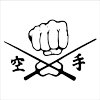Karate Techniques
-
Categories
Uraken Uchi (裏拳撃ち), Back Fist Strike
Ushiro Kokuto-Geri (), Back Heel Kick/Donkey Kick
This kick can be used when someone is directly behind you. Drive heel straight upwards targeting the groin area. You can use your heel or edge of your shoe (Ushiro-Sokuto-geri). Please see photo:
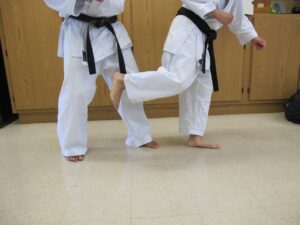
Kumade-Uchi (熊手撃ち), Bear Claw Strike
Bent Wrist Block
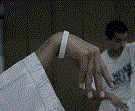
Inside Crescent Kick
Outside Crescent Kick
This kick can be used when someone is approaching behind you. Look over your shoulder to acquire target. Like a donkey’s kick, drive your heel backwards. Please see photos:
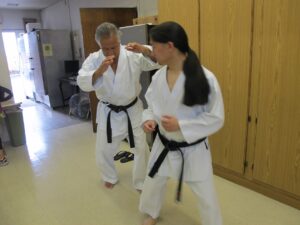
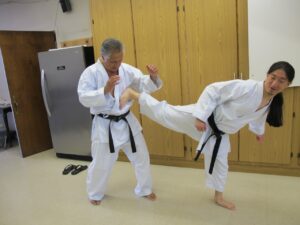
A. Intercept the incoming punch with your left hand, catching the punch near the attacker’s wrist with a knife hand block(shuto-uke). Simultaneous with the block, you are to rotate your upper body in a cone shape. Also in combination with the left hand block, you are to use your right hand (shuto) to catch the bicep of the attacker’s incoming punch. In unison, your left and right catching the incoming punch and the body rotation deflects and defeats the power of the incoming punch. A more aggressive form of this block uses the right shuto-uchi (strike) to the attacker’s lower bicep to attempt to resist the attack.
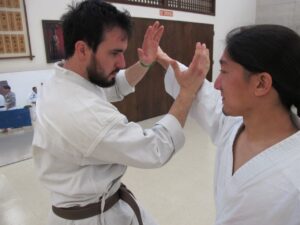
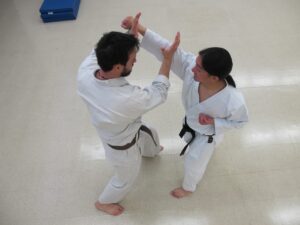
B. This is similar to the (A.) technique above with the difference of your left shuto-uke will intercept the bicep of the attacker’s right punch. Your right shuto-uke will act as a back-up block and catch the attacker’s wrist. Applied with force, the left shuto-uchi can block and deliver a pressure-point blow to the attacker’s lower bicep that may discourage future assaults. One can follow-up the block with counter attacks by 1st – switching/sliding your left hand where your right hand was the attacker’s arm – then use your right hand to deliver a shuto-uchi blow to the attacker’s neck. With your right hand in position for to grasp the shoulder and left holding the wrist – you can now deliver a hiza-ate (knee strike) to the groin or body of the attacker.
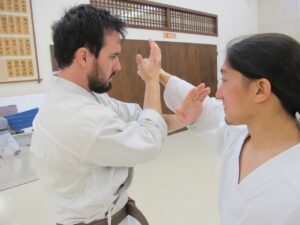
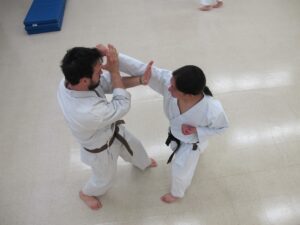
Double-Hand Block for Frontal Kick 8-11-2018
In the 1st photo, the double-hand block is better for stopping a strong kick. The 2nd photo demonstrates a counter attack to kicker’s throat. Same hand configuration as the block, but slides up to throat area.
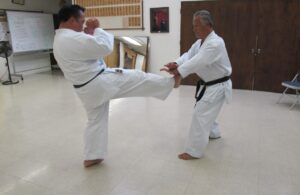
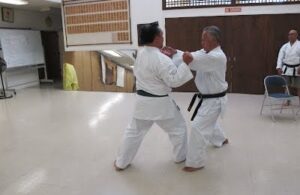
Duck Walk
Hiji-Ate (肘当て), Elbow Strike
There are three different kinds of elbow strikes:
- Standard hiji-ate strikes with the part of the forearm just below the elbow, thrown like a hook punch but with the hand touching the opposite shoulder
- Rising elbow strike uses the same part of the foream, but with the hand drawn back towards the ear as the elbow rises to attack the jaw
- Rear elbow strikes draws the fist back as in a hikite, driving the point of the elbow into the midsection, or with the elbow flared out to strike higher targets. A foreward-thrusting elbow strike as practiced in Bagua drives the tip of the elbow forward into the zyphoid process.
Stand facing partner: 1). Throw right outside/inward down block striking the forearm’s near the wrist area. 2). Throw right inside/outward block striking to same area of the forearms. Repeat with the left arm. 1/30/16.
Shuwan
Naiwan
Haiwan
Gaiwan
Kin-geri (), Front Groin Kick
Front Groin Kick Counter – Left front stance, block incoming groin kick by raising left leg to the right. Then counter by performing a Kin-geri to the attackers groin.
Mae-geri (), Front Kick
Stomp kick with heel (also used for jamming)
Mae Kekkomi-geri
meet the attacker’s punch with a glancing upward block. For example, an attacker throws a right cross and you are in a left front fighting stance. Wait until or meet the blow with your left glancing or meeting the attacker’s right forearm while protecting your head from the blow. This also places you in the position to trap the attacker’s right arm by hooking/curling your hand (inside out) on the arm. Then, simultaneously right palm heeling the attacker’s face while twisting to the left. One can then step to the outside of the attacker’s right leg for a take down.
Tetsui Uchi (鉄い撃ち), Hammer Fist Strike
Hook Kick off front leg
Cross-over Hook Kick off front leg
Spin (back) Hook Kick – see video below: 10-24-15
Kagi-tsuki (鉤突き), Hook Punch
Chūdan Uchi-Uke (中段内受け), Inside Middle Block
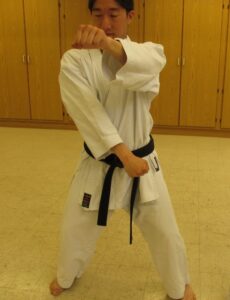
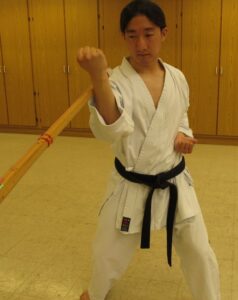
Ura-zuki (裏突き), Inverted Punch/low uppercut
Hiza Geri (), Knee Strike
Shutō Uke (手刀受け), Knife Hand Block
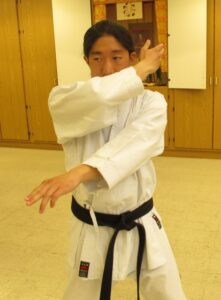
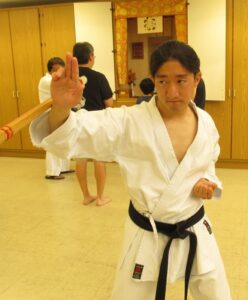
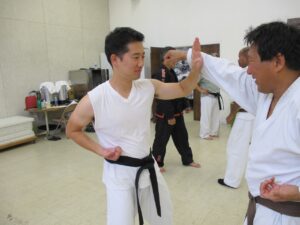
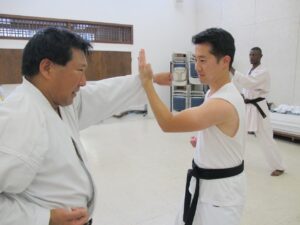
Knife Hand Roundhouse Block – often times used in connection with the cat stance 8-20-2016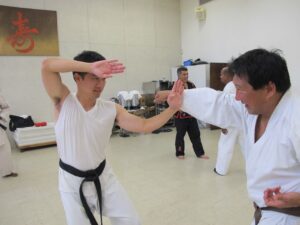
Shutō (), Knife Hand Strike
Strike Downward (to shoulder blade), across inside to outside (to the temple or throat), across outside to inside (to temple).
Gedan-barai (下段払い), Lower Forearm Block
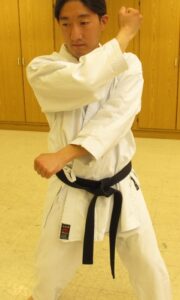
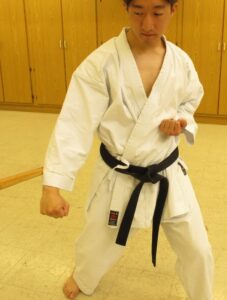
Oi-tsuki (追い突き), Lunge Punch
This technique can have different entries and applications, but is an effective move that utilizes leverage to unbalance or take down an opponent.
This uke is practicing a simple breakfall to minimize injury if the attacker doesn’t release the throw. If you manage to escape the grip, try to use your momentum to roll away safely.
Chūdan Soto-Uke (中段外受け), Outside Middle Block
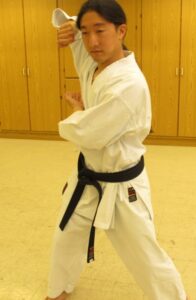
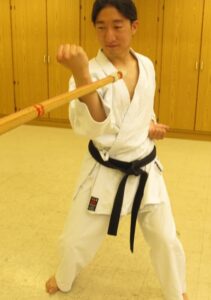
Teisho Uchi (底掌打), Palm Heel Strike
Visiting Karatekas – Katas Pinan Shodan and Pinan Nidan
We had the pleasure of practicing Karatekas from the State of Hawaii in July of 2015. The Henson family performed Katas.
Pinan Nidan – July 2015
Pinan Shodan – Steps by David Baldridge – 1-18-22
Kiotsuke – heels together, feet pointed out at 30-45 degrees. good posture, with butt and chest out, with shoulders back. Neck straight and chin slightly tucked in, with eyes set at about shoulder level. Hands come to active rest on each side.
Rei – bow keeping your upper body posture, chin tucked, bend at the waist, letting your butt move backward to counterbalance your upper body. Elbows can bend to keep hands at the same place. Don’t rush the ojigi, hold it for a few seconds then return to standing posture.
Pinan Shodan, Yoi – hands in fists cross in front then pull to the sides, maybe 4 or 5-sun from hips. Keep good posture
For Counts 1-3 – keep your body squared forward. This is basic sideways movement while maintaining forward-facing posture. More of this comes later, in Naihanchi.
-
First look to the left, then step right foot into natural stance (feet and shoulders squared forward) then double block. Right arm up block (one fist distance from forehead to blocking wrist, knuckles in line with left side of head. Left arm soto uke, natural distance with wrist at about shoulder height.
-
Bring down up block almost like a downward uchi-uke, draw the left arm back to the right shoulder making the “X” and do a down block to the left.
-
Look right first, then repeat double block to the right
-
repeat count 2 with the right hand down block
-
Look back over your right shoulder, draw right hand up to left should as you twist upper body to face “right,” turning on the balls of your feet so you are turned to face right, then do down block to your right, which is “behind” the initial position. Then do a snap kick in the same direction as the block (this is why we do the 1-2-3-4 leg raises after class!), and when you bring the foot down turn back left 90 degrees (remember you’re still squared to the “right”) to face “forward” then as your twist your left foot pulls back, and then do shuto uke.
-
Right foot step forward, right hand shuto uke
-
Left food step forward, left hand shuto uke
-
left arm drops down protecting solar plexus, fingertips around right elbow as you do nukite (spear hand) with right hand (don’t overextend!). Kiai here.
-
Turn 270 degrees to the left, turning to the “right,” with left hand shuto uke
-
Turn 45 degrees (斜め) to the right, right hand shuto uke.
-
Turn to the right to face “left”, right hand shuto uke
-
Turn 45 degrees to the left, left hand shuto uke
-
Turn 45 degrees to the left, now facing “back.” Make the “X” and do a left hand soto uke
-
Right hand punch
-
Right snap kick, just like in kihon, then stepping forward with the right foot.
-
Left hand punch
-
Left snap kick, stepping forward
-
Right hand punch
-
Right snap kick, stepping forward, then do a right down block
-
Turn 270 degrees to the left, now facing “left,” with a left hand down block
-
45 degrees to the right, up block with right hand
-
turn 135 degrees right, now facing “right,” right hand down block
-
45 degrees to the left, up block with left hand
-
step back to yoi position, facing forward”
Kiotsuke – hands back to sides
Rei – bow as before. Wait a few seconds before relaxing or Taisho (退所) and stepping back/turning with the right foot to leave.
Visiting Karatekas – Katas Pinan Shodan and Pinan Nidan
We had the pleasure of practicing Karatekas from the State of Hawaii in July of 2015. The Henson family performed Katas.
Pinan Shodan – July 2015
逆突き, Gyaku-zuki
Haitō Uchi (背刀打ち), Ridge Hand Strike
Jōdan Uke (上段受け), Rising Block
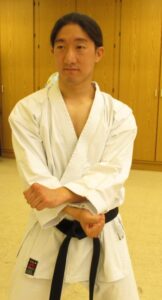

Mawashi-geri (), Roundhouse Kick
Roundhouse off the back leg ending in opposite stance
Roundhouse off the back leg ending in original stance
Roundhouse off the front leg
“45 degree” Roundhouse
Kata “Seido” Steps:
- Geri-dachi (horse stance)
- Gedan-uke (to left with left arm)
- Chudan-zuki (right fist)
- Jodan-zuki (advance forward – left fist)
- Look (right) / Gedan-uke with right arm
- Chudan-zuki with left fist
- Jodan-zuki (advance forward -right fist)
- Gedan-uke (to left) – now you are facing the same direction as you were in #1
- Chudan-zuki (advance forward – right fist)
- Chudan-zuki (advance forward – left fist)
- Jodan-zuki (advance forward – right fist with Ki)
- Chudan soto-uke: Middle outward block with left arm (backward)
- Chudan unch-uke: Middle inner block with right arm (backward)
- Jodan-uke (backward with left arm)
- Gedan-uke (to left with left arm)
- Gedan-zuki (right fist)
- Jodan-zuki (advance forward – left fist)
- Look (right) / Gaedan-uke with right arm
- Gedan-zuki (left fist)
- Jodan-zuki (right fist)
- Return to Geri-dachi (to left) – now you are facing the same direction as you were in #1.
This block can minimize an attack from behind. The classic tap/grab on the shoulder for a surprise sucker punch. For example, an attack from behind on your right. On the tap, begin to raise your right shoulder and elbow while tucking your chin tightly to your collar bone. This will help shield your jaw / temple area from a strike.
Elbow out and fist on the hip – swing elbow to block an attack coming from the side. For example, an attack from the right – Look right, right elbow block, raise right elbow with left hand underneath, shift body right strike attacker with a right elbow strike while pulling left hand opposite for optimum power.
From a natural stance throw a side stomp kick to the right with the right leg, then a side stomp kick to the left with the left leg. Repeat.
Mawashi Ushiro-geri (), Spinning Back Kick
-
Squat then at the top throw a front kick with the right leg, squat then at the top throw a front kick with the left leg.
-
Squat then at the top, throw a left side kick – repeat for a total of 3 kicks. Then switch and perform 3 kicks on the right.
Also used in combination with Judo throwing techniques. Pull and push with your hands to alter the balance of your opponent, then use the sweep on the weak leg.
Sweep off front foot using instep.
Sweep off back foot using instep.
Trapping Shutō Uke (手刀受け), Knife Hand Block
This Block uses a knife hand (Shuto) that ends in a wrist curling snap. Not clearly shown in the video is the hip rotation that greatly multiplies the effectiveness of this powerful block. This block can trap the opponents strike allowing for a counter strike.
From a fighting stance with the back leg throw a front kick, side kick, and back kick without letting the leg touch the ground.
This move starts from a whizzer (overhook), and involves spinning very fast, connecting the other shoulder to the uke’s, dropping down and pulling the arm like a seatbelt across the chest to the opposite hip
Age-tsuki (上げ突き), Uppercut or Rising Punch
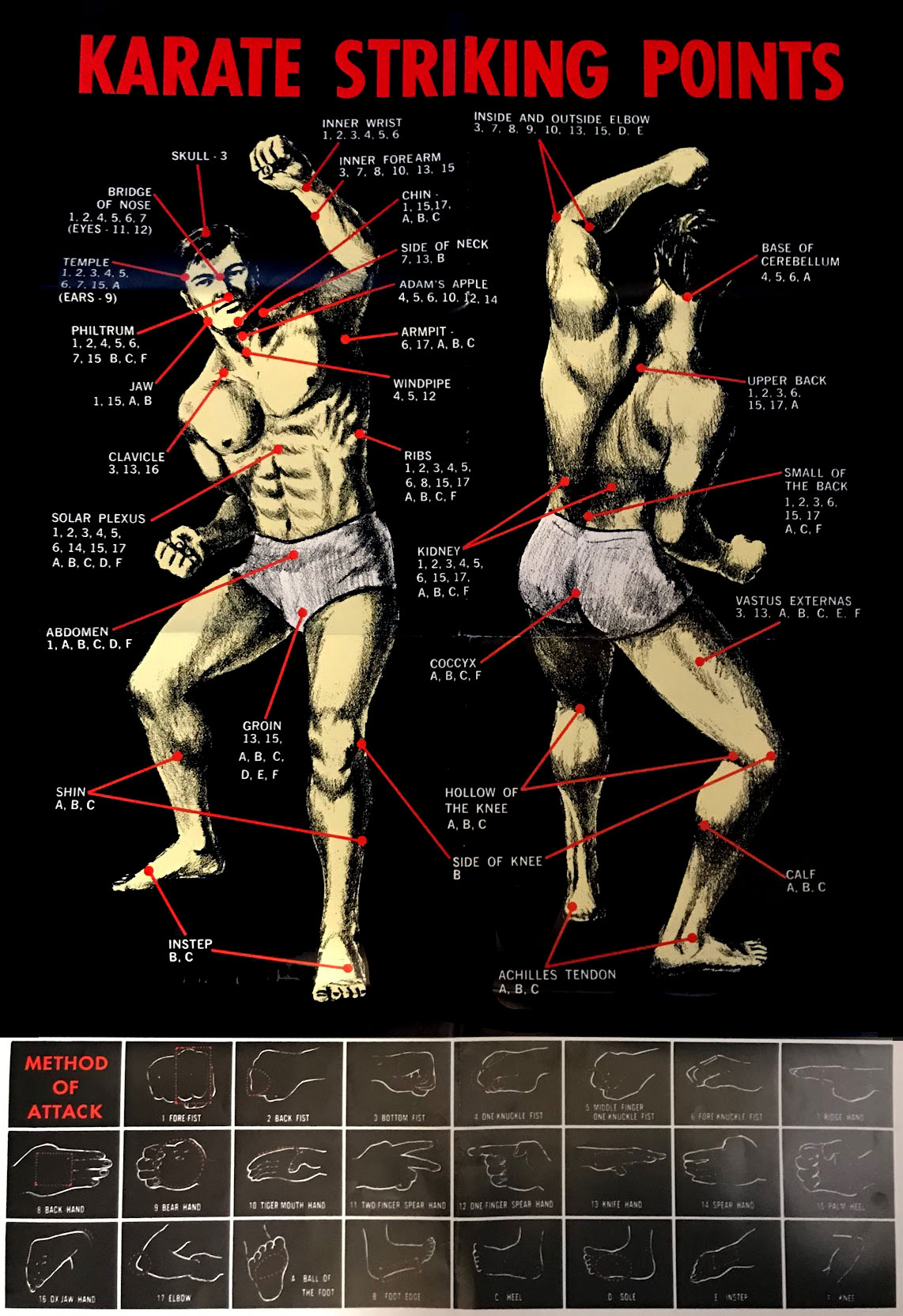
QUESTIONS?
Come train with us! Please don’t hesitate to e-mail us at koyasan.karate@gmail.com (or use the contact form below) if you have any questions

